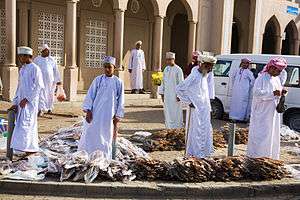Omanis
Omanis (Arabic: الشعب العماني) are the nationals of Oman. Omanis have inhabited the territory that is now Oman for thousands of years. In the eighteenth century, an alliance of traders and rulers transformed Muscat (Oman's capital) into the leading port of the Persian Gulf. Omani people are ethnically diverse; the Omani citizen population consists of many different ethnic groups. The majority of the population consists of Arabs, with many of these Arabs being Swahili language speakers and returnees from the Swahili Coast, particularly Zanzibar.
| Total population | |
|---|---|
| c. 2.67 million | |
| Regions with significant populations | |
| Languages | |
| Omani Arabic (majority) · Standard Arabic · Mehri · Balochi · Swahili · Kumzari · Luwati · Persian · Urdu · Harsusi · Bathari · Dhofari Arabic · Shihhi Arabic | |
| Religion | |
| Ibadi Islam (majority) Sunni and Shia (minority) |
Additionally, there are ethnic Balochis, Lurs, Persians and Mehri. There are also Omanis from South Asia like the Lawatis and others. [2] Moreover, in Dhofar, Sur and Muscat, people of Black African origin can be found. They are the descendants of the slaves who were brought from Africa centuries ago.[3]
Omani citizens make up the majority of Oman's total population. Over one and a half million other Omanis live in other areas of the Middle East and the Swahili Coast.
Agriculture
Most Omanis live in farming villages that are located in either the fertile valleys of Oman's mountainous interior, or along the eastern coast. Interior farmers grow dates, fruits, and grains, while coastal villagers either fish in the Gulf of Oman or work on date palm plantations. Village homes are usually made of concrete blocks, mud brick, or wood and palm thatch. In rural areas, men wear white robes, turbans, and knives in brightly colored sashes.
Society
The Omanis live in modern family units. Their society is patriarchal, or male-dominated.

Economy
Most Omanis live in villages, cities and towns. Their lifestyle has a wider variety of occupations, stronger family ties and respected women rights. They are more concerned with hospitality than with property, wealth, and education.
Most live in older whitewashed houses and are employed as officials, laborers, merchants, and sailors. An increasing number of them are also working in the petroleum industry. In 1970, Oman's new sultan introduced several developmental programs to help modernize the country. These included developing the oil industry; building new roads, hospitals and schools; and establishing adult literacy programs.
Emigration to the Swahili Coast
Omani presence in the Swahili Coast can be traced since the Nabhani dynasty.[4] In the late seventeenth century, Zanzibar became part of the overseas holdings of Oman after Saif bin Sultan, the imam of Oman, defeated the Portuguese in Mombasa, in what is now Kenya.[5]
Large numbers of Omanis settled in the Swahili Coast — especially after 1832, when the Omani Sultan Said bin Sultan moved his court to Zanzibar. To the Omanis, the region became a land of economic opportunity.
Omanis who migrated to the Swahili Coast looked forward to a better life. The Omani community in the Swahili Coast grew and became financially successful.[6] Until the middle of 20th century Omanis stopped moving to Zanzibar after a revolution has occurred in Zanzibar in 1964. The Omani descendant, sultan of Zanzibar, Sultan Jamshid bin Abdullah was overthrown, and thousands of Omanis were killed, among many other Arabs.[7] Soon after the revolution, many Omanis fled Zanzibar to avoid persecution and returned to their ancestral homeland Oman, while others chose to remain in the Swahili Coast.
Famous Omanis
.jpg)
- Qaboos bin Said al Said, the Sultan of Oman from 1970 to 2020.
- Mohammed Al Rumhi, Oman's Minister of Oil and Gas.
- Ahmad Al Harthy, Oman's top racing driver and a leading international sportsman.
- Samira bint Mohamed Al-Moosa, Oman's ambassador and permanent delegate to UNESCO.
- Qais Al Khonji, Omani entrepreneur.
- Ali Al Habsi, Oman and Reading F.C. footballer
- Ahmed bin Hamad al-Khalili, grand mufti of Oman.
- Mohammed Al Barwani, billionaire and the richest man in Oman.
- Hunaina Al-Mughairy, the ambassador of the Sultanate of Oman to the United States.
- Lutha Sultan Al Mughairy,Permanent Representative of the Sultanate to the UN.
- Madeeha bint Ahmed bin Nassir al Shibaniyah, the Minister of Education Oman.
- Yusuf bin Alawi bin Abdullah, Ministry of Foreign Affairs.
- Rawya Saud Al Busaidi, Minister of Higher Education.
- Sultan bin Mohammed al Nu'amani, Minister of Royal Office.
References and notes
- "Monthly Statistical Bulletin: October 2019" (PDF). www.ncsi.gov.om. Retrieved 21 October 2019.
- "Oman's players of Pakistan origin caught in visa mix-up". 25 February 2016.
- {{https://books.google.com.ua/books?id=MKzlyho2KQkC&pg=PA15&lpg=PA15&dq=slaves+in+sur+and+dhofar&source=bl&ots=HRqBJkWHe3&sig=MF1qpR5oNm7pINuIDxaD3zqj9Ts&hl=en&sa=X&ved=2ahUKEwiin62tg-ffAhXlkIsKHdakAF8Q6AEwBXoECAMQAQ#v=onepage&q=slaves%20in%20sur%20and%20dhofar&f=false}}
- Nabhan, Gary Paul (2008). Arab/American: Landscape, Culture, and Cuisine in Two Great Deserts. The University of Arizona Press. p. 78. ISBN 978-0-8165-2658-1. Retrieved 29 January 2015.
- Thomas, Gavin (Nov 1, 2011). The Rough Guide to Oman. Penguin. ISBN 978-1-4053-8935-8.
- "THE OMANI ASCENDANCY". http://www.britannica.com/. Retrieved 29 January 2015. External link in
|website=(help) - "Regime Banishes Sultan". The New York Times. 1964-01-14.